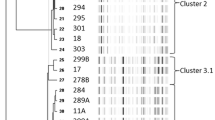Abstract
Cycloserine-Cefoxitin-Fructose Agar (CCFA) gives good presumptive identification of Clostridium difficile after 1- or 2-day incubation whereas Reinforced Clostridial Medium (RCM)/p-cresol is not very selective for the organism from the vagina. The identification of 91.5% of the isolates from an initial screen subjected to biochemically based tests was achieved. Conventional screening of vaginal swabs failed to confirm any significant occurrence of Cl. difficile in the vagina of pregnant or non-pregnant women. The incorporation of an enrichment stage in the isolation procedure, however, did reveal a significant presence of the organism in the vagina of both pregnant and non-pregnant women.
Similar content being viewed by others
References
Bryant, M. P. and Burkey, L. A. 1953. Cultural methods and some characteristics of some of the more numerous groups of bacteria in the bovine rumen.—J. Dairy Sci. 36: 205–217.
Corbishley, C. M. 1977. Microbial flora of the vagina and cervix.—J. Clin. Pathol. 30: 745–748.
George, W. L., Sutter, V. L., Citron, D. and Finegold, S. M. 1979. Selective and differential medium for isolation of Clostridium difficile.—J. Clin. Microbiol. 9: 214–219.
Gorbach, S. L., Menda, K. B., Thadepalli, H. and Keith, L. 1973. Ahaerobic microflora of the cervix in healthy women.—Am. J. Obstet. Gynecol. 117: 1053–1055.
Hafiz, S., McEntegart, M. G., Morton, R. S. and Waitkins, S. A. 1975. Clostridium difficile in the urogenital tract of males and females.—Lancet i: 420–421.
Hafiz, S. and Oakley, C. L. 1976. Clostridium difficile: isolation and characteristics.—J. Med. Microbiol. 9: 129–136.
Holdeman, L. V., Cato, E. P. and Moore, W. E. C. 1977. Anaerobe Laboratory Manual, Fourth edition. — Virginia Polytechnic Institute, Blacksburg, Virginia.
Larson, H. E., Barclay, F. E., Honour, P. and Hill, I. D. 1982. Epidemiology of Clostridium difficile in infants.—J. Infect. Dis. 146: 727–733.
Lindner, J. G. E. M., Plantema, F. H. F. and Hoogkamp-Korstanje, J. A. A. 1978. Quantitative studies of the vaginal flora of healthy women and of obstetric and gynaecological patients.—J. Med. Microbiol. 11: 233–241.
O'Farrell, S., Wilks, M., Nash, J. and Tabaqchali, S. 1984. A selective enrichment broth for the isolation of Clostridium difficile.—J. Clin. Pathol. 37: 98–99.
Stark, P. L., Lee, A. and Parsonage, B. D. 1982. Colonization of the large bowel by Clostridium difficile in healthy infants: quantitative study.—Infect. Immun. 35: 895–899.
Author information
Authors and Affiliations
Rights and permissions
About this article
Cite this article
Thirkell, D., Thakker, B., Herriot, A. et al. A screen for Clostridium difficile in the vagina: an out-patient study using and comparing selective media. Antonie van Leeuwenhoek 50, 355–360 (1984). https://doi.org/10.1007/BF00394649
Received:
Issue Date:
DOI: https://doi.org/10.1007/BF00394649




